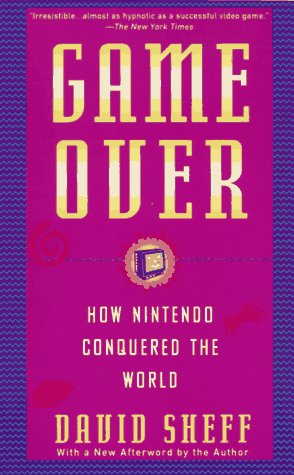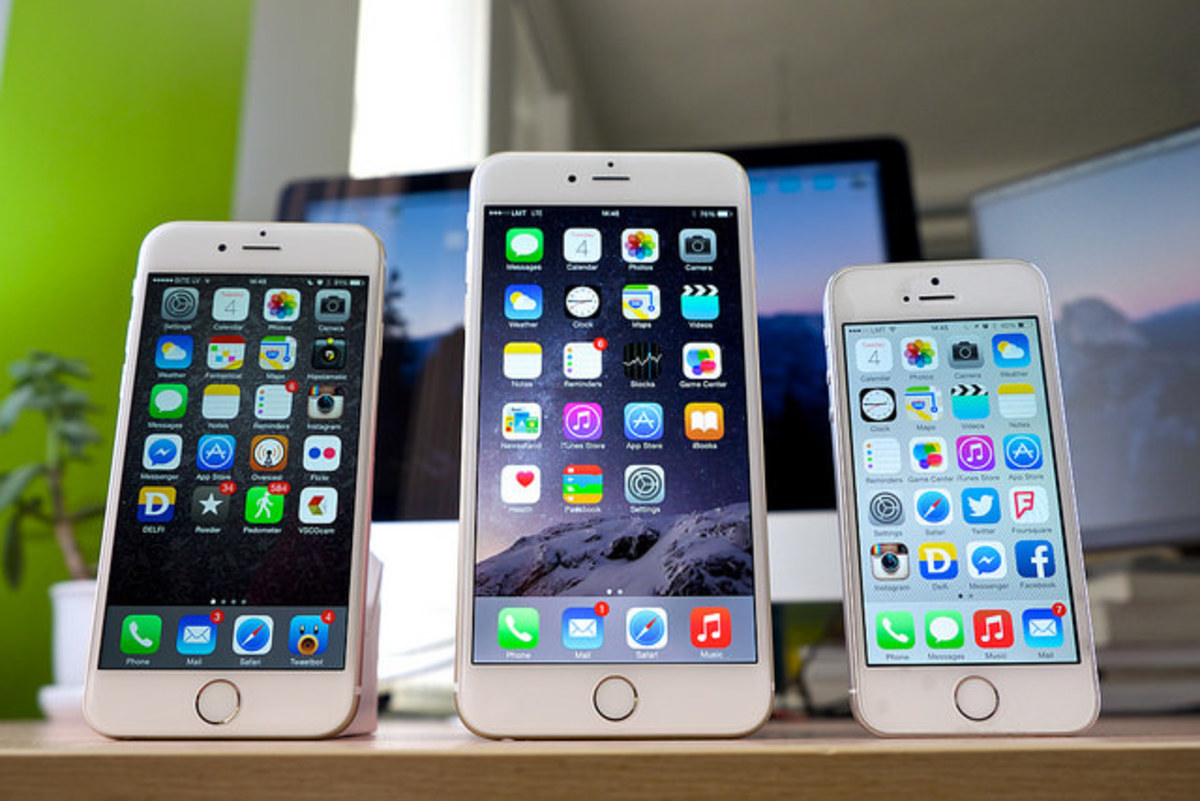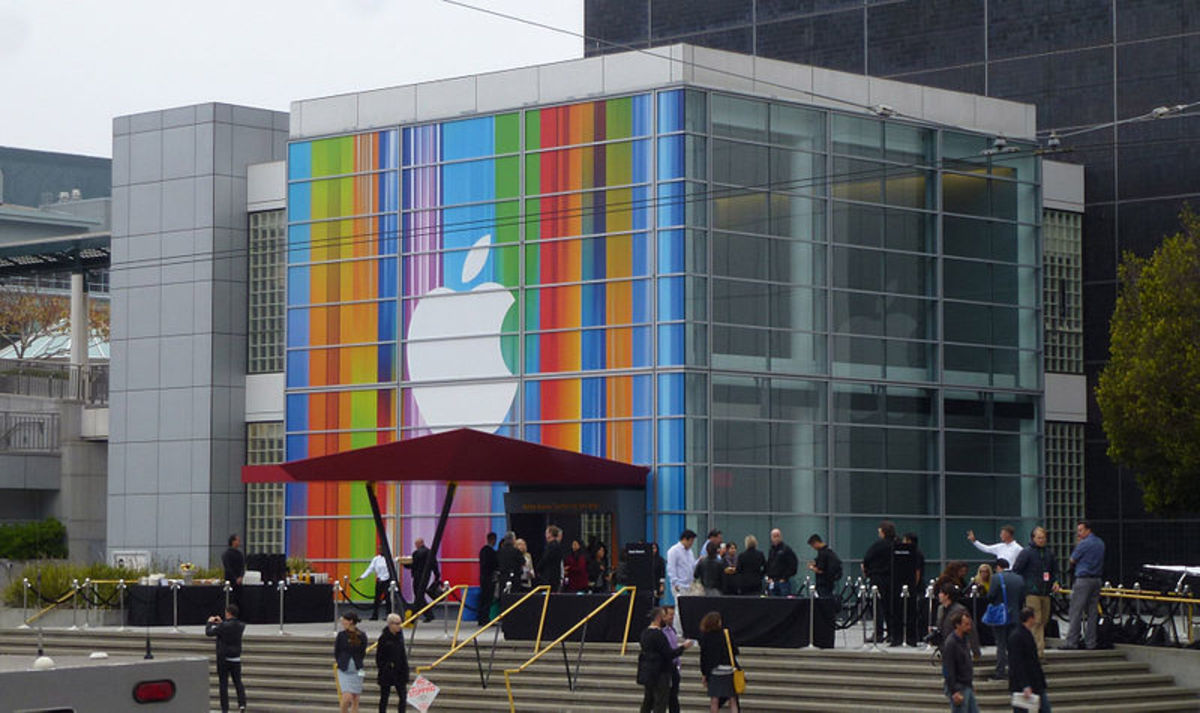Tech Legacy: 7 Modern Tech Products and Their Recent Ancestors
Introduction
We are surrounded today by technical marvels. Motion control like Wiimote, tablet computers like iPad, and much more are now readily available at consumer prices. However, all these devices have ancestors. They all came from something. Let us take a short journey into the tech past and dig up some ancestors of modern technologies, and you may be surprised what you believed to be new, is anything but new.
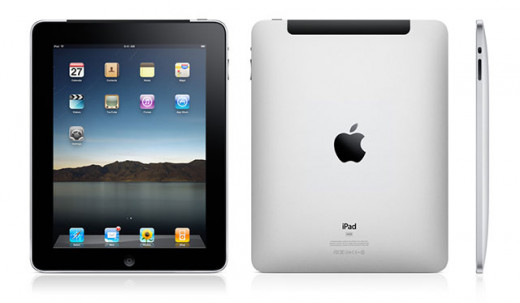
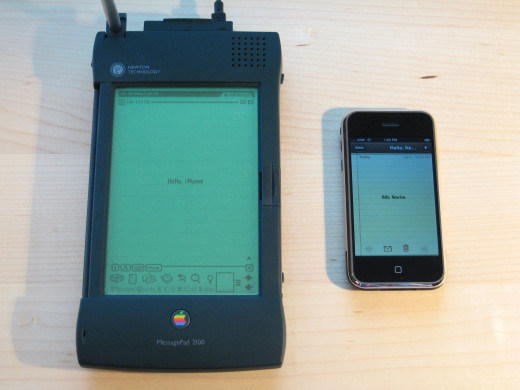
Apple iPad Mini / Apple Newton MessagePad
Apple iPad is now ubiquitous, almost as popular as iPhones, and comes in two sizes. While iPad was only launched in 2010, few people remembered its predecessor... The Apple Newton. (see right).
The Newton, launched in 1993, was way ahead of its time. It has hand writing recognition that is arguable BETTER than what's available a decade later, albeit due to the technology available at the time, a stylus had to be used, and the screen resolution is limited to 336x240 black and white. The final model, dated 1997, pushed that to 480x320 with 16-gray levels, but it never got color.
The Newton was one of the most innovative projects at Apple during Steve Jobs' absence. However, it was also feared that if they really develop this it will eat into sales of the Macintosh, then Apple's primary business. Thus, it was always pushed as an accessory, not a replacement of a PC. In fact, the term "PDA", or personal digital assistant, was coined by then Apple CEO Gil Amelio, to describe the Newton. There never was anything like it before.
The PDA was extremely innovative for its time, with what's known as "soup" storage... all the data entered is free-form, and can be handled by any other program. Instead of each program keeping its own data, there is ONE common pool of data, rather than separate address, phone, photo, etc. You simply create links between bits of data, and then to the programs that can access them. It made for flexibility that had never been seen before or since, though it had hard time dealing with regular files and documents.
Unfortunately, the handwriting was not quite perfect, and battery life is about as bad as is iPads of today... barely lasting one full day of use. When Steve Jobs came back to Apple, Newton had to go. Though the spirit of it lived on, and eventually evolved into the iPod, and later, the iOS devices such as the iPad.
The Newton, however, also inspired another cousin, which went on to invent yet another revolution... the smartphone.
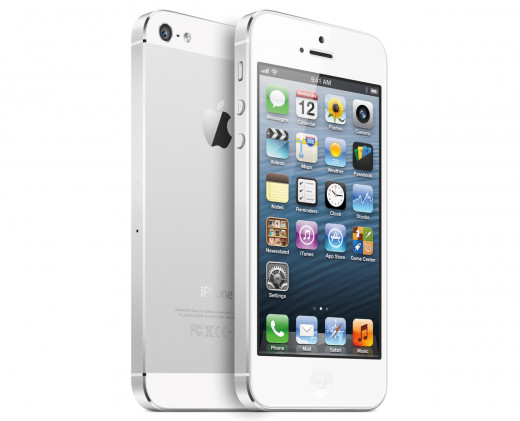
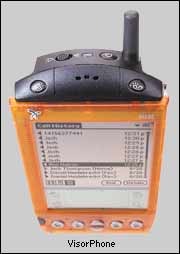
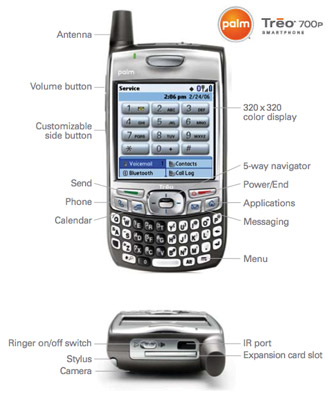
iPhone (or any modern smartphone) / VisorPhone and Treo
iPhones are even more ubiquitous than iPads, and the smartphone scene now is so common, that most people no longer know where did the first smart phones came from. The truth is simple... they share a common ancestor... the Apple Newton.
Apple's Newton was shut down in 1997, but the term PDA, or personal digital assistant, lived on, when new processors and other technological advances, plus a bit of compromise, lead to the rise of a new company, called Palm Computing.
Palm Computing was a new venture by U.S. Robotics, then a manufacturer of PC modems and communications equipment, into a new arena: PDAs. It was started in 1996, and it produced the first palm-sized PDA known as the "PalmPilot". About size of a large wallet, it is much more portable than the "tablet" sized Newton. By using an abbreviated handwriting system known as Graffiti, and a much simpler icon launcher, it was able to offer quite a bit of Newton's capability in a pocket-sized device, and it can be sync'ed with a PC with a sync cable. And the battery lasts for weeks.
After 3COM acquired US Robotics, and by extension, Palm Computing, the original creators of Palm (no longer called Palm Pilot due to a trademark dispute with Pilot Pens) left to create "Handspring" company. Their first device, the Handspring Visor, runs licensed copy of Palm OS, albeit with an expansion slot known as "Handspring slot". And it is this slot that gave rise to the first true smartphone, the VisorPhone, launched in 2001.
As you can see the picture on the right, the orange part is the Visor PDA itself, and the module fits on the top and back. It is a full GSM phone, but with no keypad (PDA does that), but with a SIM slot. It will allow you to dial numbers from your contact app, as well as bring up a keypad to dial numbers directly. It will also send and receive SMS, reply with canned messages, and even browse the web using a WAP web browser, albeit very slowly.
Handspring went on to create the Treo communicator (see right), which is basically a PDA with a hard keyboard, and a phone, which inspired the Blackberry. Final versions have microSD card slot, Blueooth, camera, and more.
Palm bought Handspring a few years later, merging it back into the company, then after it was about to fail, got itself purchased by Hewlett Packard. However, the Treo line never did evolve much beyond that first model, except there's a version that runs WIndows Mobile instead of PalmOS.
Treo, along with the Newton, are what inspired Steve Jobs to add phone capability to the iPod, and created the iPhone.
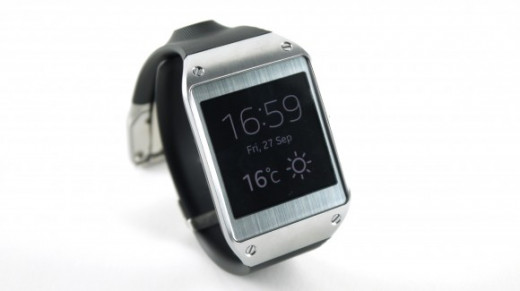
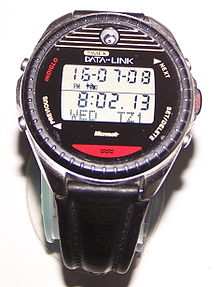
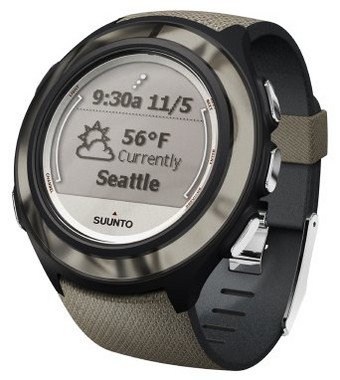
SmartWatch / Timex DataLink / Microsoft SPOT
With Samsung GalaxyGear already launched (see right), Pebble Smartwatch shipping, and alleged Apple iWatch coming soon, most people probably forgot all about the first wearable computer: the Timex Datalink (see right), developed in cooperation with Microsoft.
Timex, looking for something more exotic, teamed up with Microsoft to come up with an innovative way to wear a watch with functions of a PDA, and the result is the data link, which mostly require a PC to function. Basically, you run a calendar program on the PC, which keeps track of anniversaries, alarms, notes, and other bits of info, and periodically, you can "beam" over the relevant bits of info to the watch through the "datalink", simply by starting the link process, and point the watch toward the screen. The screen will flash a unique pattern, which allows the watch to receive the data via that big sensor on top. Obviously, the note sizes are limited, and anniversaries, alarms, and such are only kept for 7 days or so, but for many people that is enough.
The Timex Datalink watches also gained notoriety as astronaut watches. Many of them flew in space. The one on the right was worn by two astronauts on the ISS.
The watches themselves are quite limited and has no serious functionalities other than as portable displays of some bits of info. It has little to no computing functions, and the datalink does not work with LCD screens, forcing Timex to create a special notebook adapter which has a special flashing LED through Serial port that can transfer data same as CRT screen flash method. Later versions of datalink works over USB ports.
Timex DataLink was later succeeded by a new Microsoft Initiative called SPOT (smart personal objects technology) around 2004 and several watches were created by Fossil, Suuntu, and later, Swatch and Tissot. This one no longer relies on local PC, but rather, downloads relevant data through a special FM transmission operated by "MSN Direct", part of Microsoft. It is subscription only though, at $59 a year. The SPOT devices have Outlook integration, news alerts, weather updates, and for a while, traffic updates. SPOT watches are also known to be one of the first to use inductive charger. Just place the watch on its stand (which is plugged to the wall) to recharge for next day. However, with widespread adoption of data transmission such as Sirius, and RDS, Microsoft's transmission tech was never widely adopted, and it was shut down in 2011.
Modern smartwatches, with their own connectivity such as Bluetooth, WiFi, Cellular data, and more are more like miniature smartphones than PDAs, but there's no doubt that they owe their existence to their forerunners such as SPOT and Datalink, as well as to the smartphones.
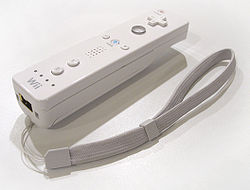
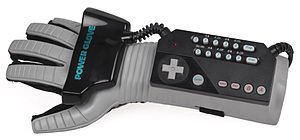
Nintendo Wii Remote / Nintendo PowerGlove
Nintendo's Wii Remote, i.e. Wiimote, announced in 2005 and available 2006, was a part of Wii console's primary feature: motion tracking interface. Just wave the wii-mote in your hand as if you're swinging a bat, thrusting a sword, or any other motion, and it will be sensed as controller input. It is so natural that joysticks and gamepads are obsolete, it seems. However, few can remember Nintendo's first attempt at direct motion interface: the Nintendo PowerGlove, circa 1989, for the original Nintendo Entertainment System, aka the "NES".
Nintendo actually did not develop the PowerGlove. It was created by Abrams Gentile Entertainment (AGE) and manufactured by Mattel in the US (and PAX in Japan). It uses 3 ultrasound transmitters to be mounted near the TV, and two microphones within the glove itself, to sense the movements even though it is not a true 6-axis controller. Due to limitations of only 2 microphones in the glove, it can sense yaw and roll, but it cannot detect pitch. The accuracy was also not that good due to limitations of the sensors. However, it is cool, and it works to a limited extent.
Still, the PowerGlove was a bust, as it only sold 100000 units in the US and only TWO GAMES take special advantage of its 3D movement capabilities. Still, it inspired a lot of homebrew projects into Virtual Reality as well as made an appearance in "The Wizard".
It took another 15 years for Nintendo to bring motion controller back to consumer market, with the Wii Remote, which uses accelerameters instead of ultrasound sensors. However, the Wiimote also has optical sensors to detect the "sensor bar" which is to be placed near the screen, and that is very reminiscent of the ultrasound 'bracket' of the original PowerGlove.
The Original WiiMote is quite inaccurate, forcing Nintendo to quickly creat "MotionPlus" expansion attachment for the WiiMote, which added a gyroscope module to increase motion accuracy. Later version of the WiiMote, known as Wii Remote Plus, has the MotionPlus gyroscope built-in.
Cloud-based Gaming / GameLine, Play Cable, and Sega Channel
In 2010, cloud-gaming came alive when OnLive went into service and Gaikai was demo'ed. Both allow players to play games that are NOT installed on their local machine, but instead, is downloaded or streamed from an outside server. What you probably don't know is this is NOT new at all. GameLine did this back in... 1981, for the Atari 2600.
In 1981, William Von Meister, and his Control Video Corporation, created Gameline, which is an oversized Atari 2600 cartridge with a phonejack (RJ-11). Plug the phone line into it, and it can access a central server to download a game to the cartridge to be played locally for a fee, and allows play of between 5 and 10 sessions. After which the game must be downloaded again (for another fee). Unfortunately, Gameline never was able to convince big game publishers to grant him a license to rent big name games. As a result, selection of games was always a bit esoteric and consists of small publishers. Control Video Corporation was ruined in the great Video Game Crash of 1983.
Intellivision, a contemporary competitor to Atari 2600, has a similar device known as PlayCable, albeit PlayCable take advantage of the cable TV service, whereas GameLine uses regular phone lines. Like GameLine, PlayCable died in 1983, and nobody tried again for eleven years.
In 1994, Sega Genesis got a new accessory, the Sega Channel adapter. Players, for $14.95 a month, can get access to 50 games (selection changes every month) plus special announcements, demos, and more, directly through the cable company. Just plug the Channel adapter into the console as if it's a game cartridge, power the unit through the included AC Adapter, and plug in the coax cable via a splitter, and you can choose from any of the 50 games that month. Play as much as you want, download a different one... do anything you like. This was an instant hit, available to up to 1/3rd of US households at its peak, as well as multiple world markets.
Due to the need to improve quality of the signal to ensure the game downloading works properly, Sega also encouraged the cable operators to improve their lines. This, plus additional equipment and efforto to integrate billing services, as well as purchase the adapters from the manufacturers, makes some cable operators hesitant. Soon, the rapid advance of the console market away from 16-bit consoles, and rise of Internet, lead to death of the Sega Channel merely four years later, in 1998.
The idea of downloading a game and play it only when you want it is alive today. And that leads us to a very modern gaming console...
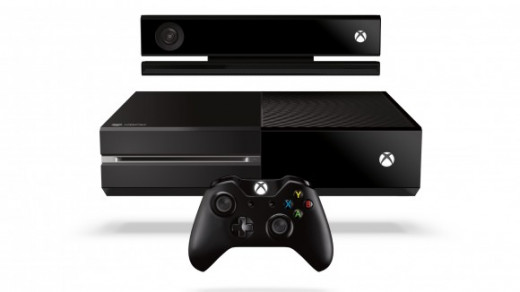
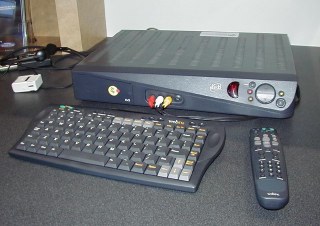
Microsoft Xbox series / Microsoft WebTV
With Microsoft Xbox One just around the corner, everybody by now has probably heard of the original Xbox and the much better known cousin, the Xbox 360 gaming console. What you may not have known is they owe their existence to a little device called WebTV.
WebTV was a true Silicon Valley garage startup, that spent all their money into this device that promise to turn your TV into the gateway to the wonder world if Internet, without learning about computers and operating systems and TCP/IP and such esoteric terms. Plug and go was their intent. Company itself was incorporated in 1995, and by the time it launched its product in 1996 money had run out, and then... Microsoft bought the whole company and renamed it MSN TV.
MSN TV was never quite the success it should have been, as the web was never really meant to be used on the smaller TV with its low resolution (this is before HDTV). However, as a part of Microsoft effort to go TV, MSNTV also developed a lot of hardware for Microsoft, including a MSN TV Adapter for the Sega Dreamcast console, circa 1999, which is reminiscent of Sega Channel adapter mentioned earlier (circa 1994).
Microsoft learned a lot about the hardware market and game consoles due to that partnership with SEGA. Add that to their Internet settop box experience, lead to the Microsoft Xbox (circa 2001), the Xbox 360 (circa 2005), and now, the Xbox One (circa 2013).
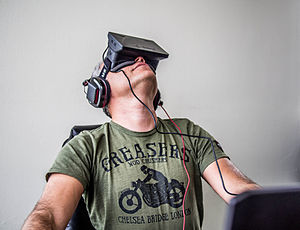
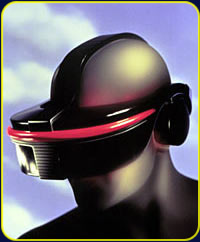
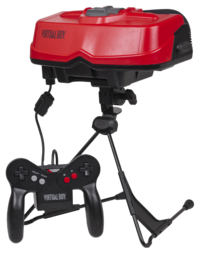
Oculus Rift / Sega VR / Nintendo Virtual Boy
Oculus Rift will be the first mass market head mounted virtual reality display with a lot of PC game support. However, it certainly was NOT the first 3D display. That honor belongs to one of the few Nintendo flops by the name of Virtual Boy. But first, a bit of history lesson.
The time is early 1990s. Nintendo and Sega have seen their 16-bit consoles basically won the console wars, but they are late getting their 32-bit consoles out the door. PC hardware cost a FORTUNE, and this is the era of the 80486 (Pentium didn't hit the market until 1993) when PC's have price tag of $1500 to 2000 dollars, and out of reach of most households, much less any peripherals for VR. The computing power just isn't there.
Sega fired the first salvo when it announced "Sega VR" in 1991, which seem to be based on an IDEO head mounted display with a special interface connecting it to the Sega Saturn console. it will have head tracking and such sampling head movement and orientation at 100 times per second. It will have stereo sound. It was going to be awesome! Except it was never released. Last time it was shown at CES 1993, then it was never seen again, ever. Sega claimed that it was cancelled because tests showed that users can hurt themselves because it was TOO realistic. I call baloney.
Nintendo wanted something innovative now that Sega is no longer playing, and it has a 3-team system where two teams work on breakthrough products while one team work on a core product, and then the roles switch. When the 32-bit console (Which eventually became the Nintendo 64) was delayed, one of the other two teams, headed by Gunpei Yokai, showed off this design of two small displays directly in front of the player's eyes to produce stereoscopic 3D effect. Gunpei Yokai was one of the original creators of "Game and Watch" for Nintendo, as well as being the original creator of Game boy. Thus his idea was chosen to be the next major release.
The idea turned out to be harder to implement and keeping the cost down. In the console business, the console themselves are cheap family fun, and thus cannot cost a fortune. The personal gaming devices like Game boy are even cheaper. This product, which became known as the "Virtual Boy", is a personal gaming device (only one user), yet it is priced much like a console ($180, just below then common console price of $200). To save on costs, Yokai settled for red LEDs as the primary light source of the display, thus creating an all red screen that is almost universally hated. The display also is NOT LCD or LED, but is a technology known as "scanned linear array", where a row of LEDs, forming a 244x1 pixel array, shines its light onto a spinning mirror which then reflects the light onto the display, and the scanning effect creates the 2D image. The two motors driving the two spinning mirrors creates a constant humming noise while the unit's on.
From the beginning the device had marketing problems. Nintendo, not wanting to cut into potential Nintendo 64 sales, marketed the virtual boy as a Game boy replacement, not as a brand new console Yokai had intended, mainly by cutting down the device to a bare minimum to run. Instead of a head harness for more freedom of movement, a small tripod was used so the user have to lean on the table to peer into the viewfinder. The harness was promised but never shipped. There is no gyroscope or inertial sensor in the viewer. Head movement is irrelevant, which annoyed many users, expecting something closer to a VR viewer. Apparently marketing campaign over-promised and under-delivered.
Nintendo launched the console in 1995, hoping to sell several million units. Unfortunately, the monochromatic red screen, the lack of games, the lousy 3D effect, and more forced the console to be cancelled less than a year later. Reports by newspapers of players becoming violently sick did not help. Total units sold was about 770000, way short of several million hoped for. It seems that every attempt at marketing the console was a failure. So much so, it was named #5 in Ten Worst Selling Game Console of All Time. Yokai was ousted from Nintendo for this failure. And it took Nintendo 15 years to try 3D again with the Nintendo 3DS.
Still, it seems the subsequent attempts at personal 3D have taken all the lessons from the Sega VR and Nintendo Virtual Boy to heart. Oculus Rift has full color displays in front of both eyes for natural look, and full 6 degrees of freedom head tracking thanks to modern gyroscopes and accelerometers. It also enjoys widespread game support.
Conclusion
I hope you have enjoyed this trip down memory lane, and how technology is one huge intertwined story, where true innovation is rare, and often, it's just being at the right place, at the right time, with the right solution. Modern marvels have their predecessors and previous iterations if you look for them.
Have fun out there.
© 2013 kschang



